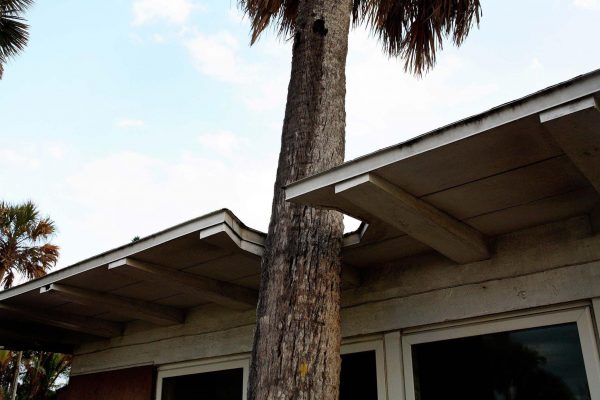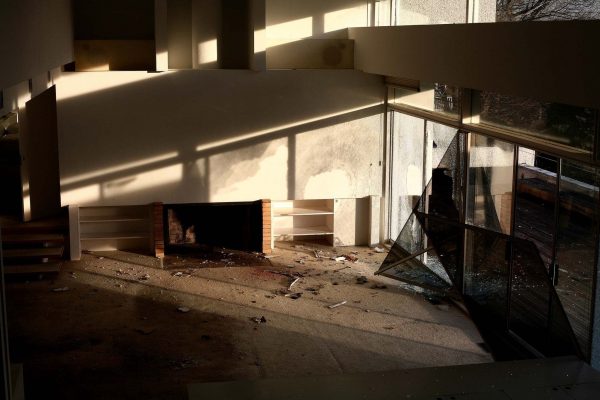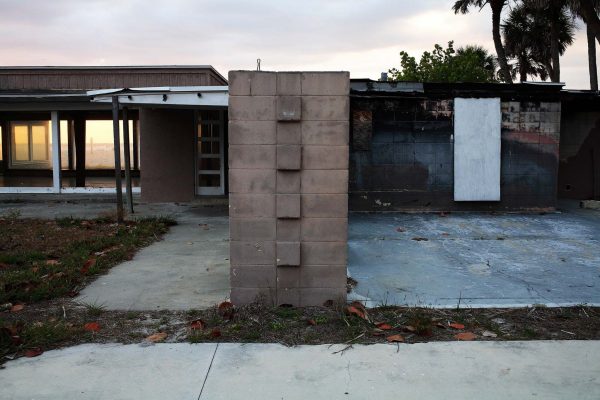After you left /
they took it apart
Photography by Chris Mottalini
Written by Alison Arief
In the visual lexicon of modern architecture, photographer Julius Shulman achieved something few others could: he showed that these houses, far from being cold and inhumane, were instead warm, sunny enclaves perfect for imbibing elegant pitchers of martinis or living out idyllic childhoods. Architecture was paramount in these images, to be sure, but equally important were the people depicted in them, people who activated those modern spaces by their very presence. Though Shulman’s images were as elaborately staged as a Broadway production, they presented a lifestyle anyone would aspire to. These pictures are as much about possibility—if not more so—as they are about building.

The Twitchell House; Siesta Key, FL (1941–2007). Designed by Paul Rudolph
Post-Shulman, architectural photographers seem to have followed two tracts: gleaming portraits of monumentality vs. the leave-the-laundry-and-the-lemons-out lifestyle shots char- acteristic of shelter publications like Dwell. Both are aspirational in their own way. The former inspires the architect, the latter her client. But there exists a subgenre (and I’m being admittedly reductionist here) that some term “ruin porn”—images of structures that have fallen into disrepair or worse. These images are less nostalgic than elegiac, a glimpse of what’s been lost.
After You Left / They Took It Apart: Demolished Paul Rudolph Homes, Chris Mottalini’s series of images of three of Paul Rudolph’s demolished homes, are the antithesis of ruin porn; they’re not aestheticizing the loss, but restoring these structures’ dignity. Doing that doesn’t bring these houses back, but it’s a welcome form of remembrance for an architect and an architectural genre that don’t always get the respect they deserve. It’s not easy being a modernist building; it’s even harder being a neglected one.
Modern buildings are old but often not old enough to be considered “historic” (and therefore worth saving). Design that felt cutting edge at midcentury may indeed still feel too avant-garde to people viewing it today (even when the replacement structure is tacky eighties contemporary). The lucky modern structures have devoted residents (like most of the midcentury modernist icons) or generous endowments to keep them in mint condition (say, Frank Lloyd Wright’s Falling Water) and/or are concentrated in modern-friendly locales like Los Angeles, a city particularly welcoming of a diversity of architectural styles. But many neglected works sit awaiting saviors, often unable to be saved from the wrecking ball.

The Micheels House; Westport, CT (1972–2007). Designed by Paul Rudolph
One of the harder-hit modernists has been the architect Paul Rudolph. The former chairman of the department of architecture at Yale left a powerful legacy: his Beekman Place townhouse in Manhattan, his Brutalist Art and Architecture building at Yale (which recently underwent an extensive, acclaimed renovation), and his gorgeous Florida beach houses, which were deemed worthy of their own period moniker (Sarasota Modern). Too many of his buildings have met with the wrecking ball. Too few have rallied to the cause of his architecture. Indeed, many have passionately called for its destruction: as part of the New York Times’ Room for Debate series exploring the question, “Are Some Buildings Too Ugly to Survive?” critic Anthony Daniels, after equating modern buildings to “fallout shelters,” suggested that those who want to preserve them desire to do so only because “they want to deny their past crimes against humanity, beauty and the townscape.” Buildings cannot be better than they look, he argued, adding, “Preserve one and pull the rest down.” Daniels is not alone in his disdain for Rudolph and his Brutalist buildings.
More than perhaps any of his peers, Rudolph’s buildings are either under threat or have already been destroyed. Preservation magazine called the demolition of Rudolph’s Riverview High School in Florida one of “the most crushing losses of historic buildings throughout the country” in 2009. And at the time of this writing, his Orange County Government Center had received a reprieve, though the outlook for the “leaky landmark” (as one news outlet described it) is tenuous at best.
The question of what to preserve and what to destroy is nearly always fraught, but Mottalini feels that people let their personal tastes get in the way of their decision-making process. “There’s no accounting for personal taste … which is kind of the problem. I don’t think that personal taste should be allowed to enter into the discussion, when we’re basically talking about preserving an important part of this country’s architectural heritage and landscape.” Mottalini hopes that After You Left / They Took It Apart stands as a testament to the power of architecture. And, as he explains, photographing these homes seemed like the only way to actually save them.

The Twitchell House; Siesta Key, FL (1941–2007). Designed by Paul Rudolph
The Rudolph Foundation had approached Mottalini to shoot the Micheels House (built in 1972) before its demolition in 2007 in Westport, Connecticut. The photographer’s reaction upon seeing the building, he explains, was “immediate and powerful. It really only took a short time walking around that fantastic, tragic house for me to be hooked on all things Paul Rudolph.”
His interest piqued, Mottalini was eager to shoot one Rudolph after another. To date, he has, in his estimation, probably photographed around thirty Rudolph buildings, including the two demolished along with the Micheels House in 2007; the Cerrito House in Watch Hill, Rhode Island; and the Twitchell House in Siesta Key, Florida. “I’ve seen his projects in varying states … some in excellent, lovingly preserved condition and some that are not doing so well, or, in the case of [the homes in] After You Left …, that have been wiped clean off the map, as though they never existed.”
Chris Mottalini’s series of images
of three of Paul Rudolph’s demolished homes are the antithesis of ruin porn
Mottalini’s photographs are haunting—one can conjure up past residents and the lives they lived. One feels the emptiness profoundly and it is not a surprise to hear Marlene Cerrito, whose father had commissioned Rudolph to design the family
home in 1955, recall that, “When they sold the house, they put everything in storage. The warehouse burned down and so we lost all of our family photos and everything except for a few pans and the housewarming gift that Paul gave my parents.”
While most reveal the loss of some truly elegant architec- ture, there are, it must be said, some views that seem to support the position of the demo crew (all that stucco!). Mottalini understands where both sides are coming from: “[Rudolph’s] is a very striking, dominant, powerful style, which seems to be at odds with the type of modern architecture that is popular today. I think many people think it feels dated. His style is recognizably his, modernist and, oftentimes, Brutalist. It’s not for the faint of heart.”
Shooting this project gave Mottalini great insight into just how difficult preservation is. Homeowners today seem more interested in square footage and screening rooms than living in a work of art. “I of course understand that every person has a different idea of what is beautiful and what they want in a home … maybe this is just how it goes.”
“It’s probably a good thing,” he adds, that “Rudolph isn’t alive to see this happen to his work.”
See more in At Large Magazine vol. 2